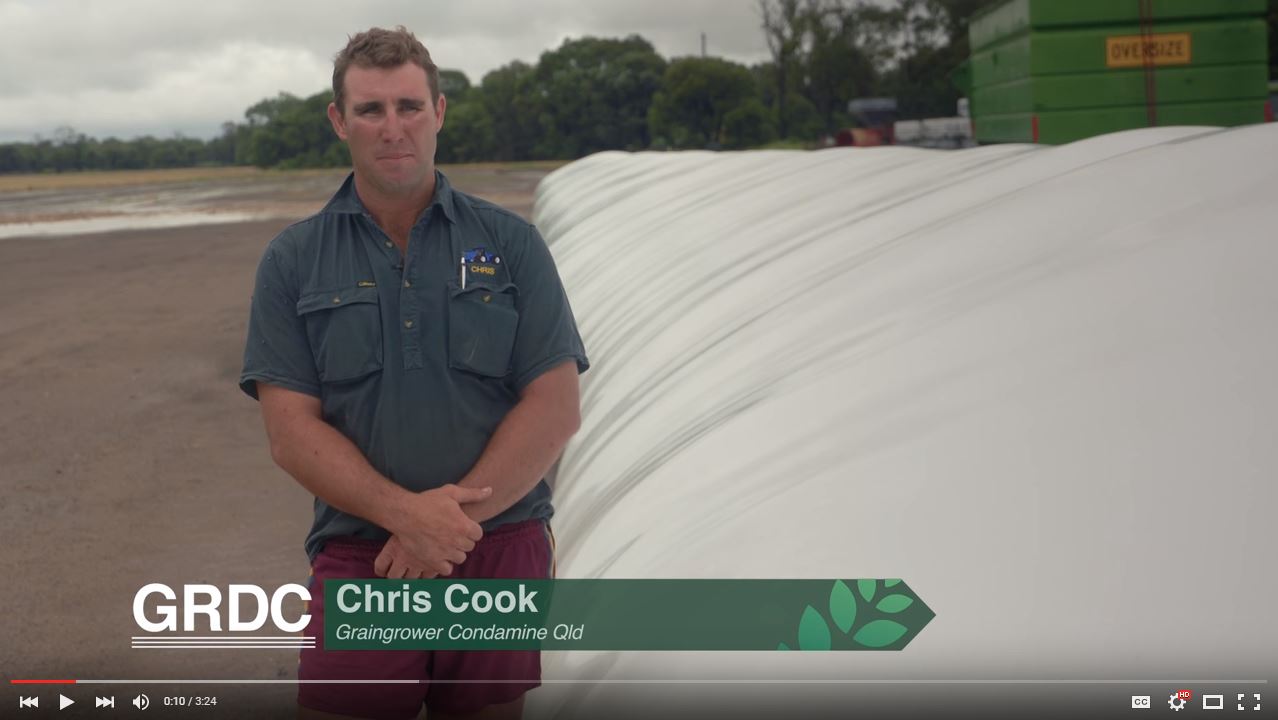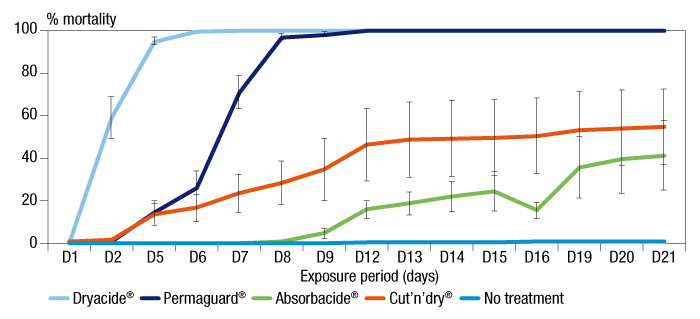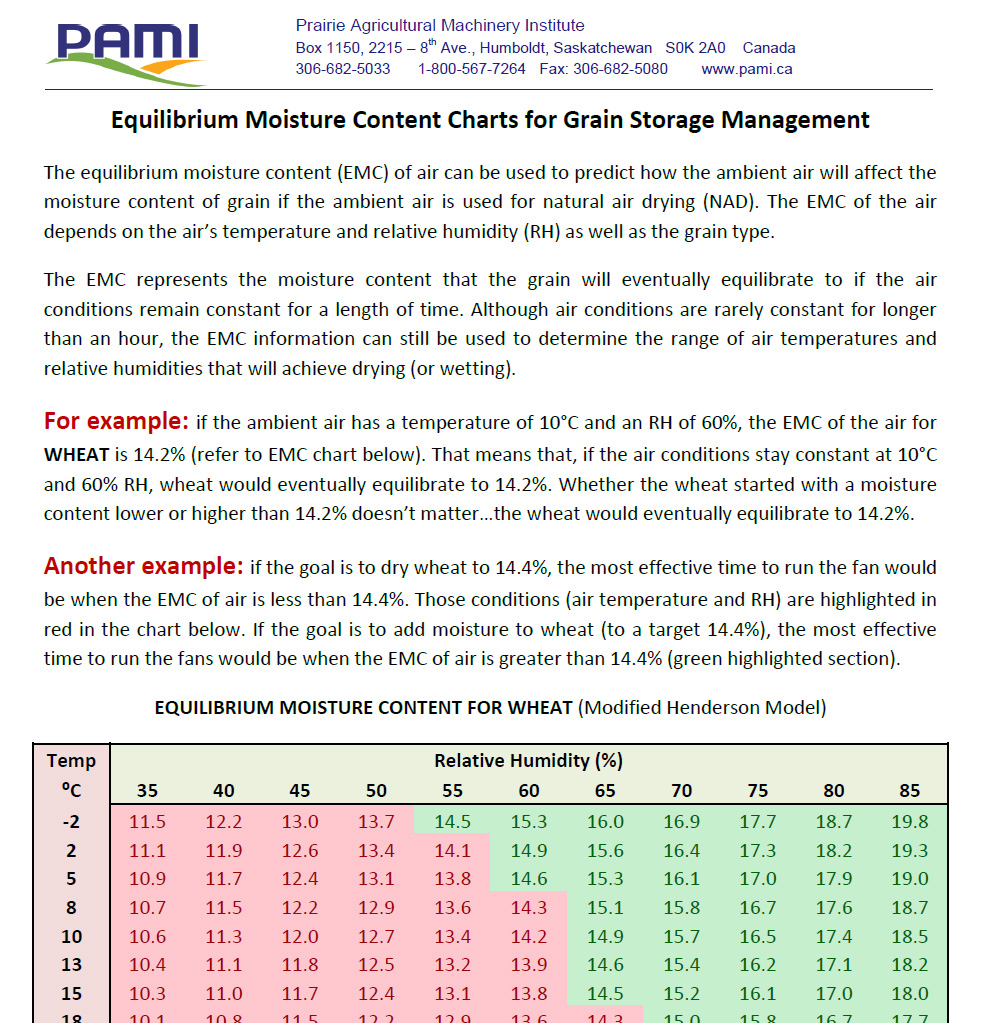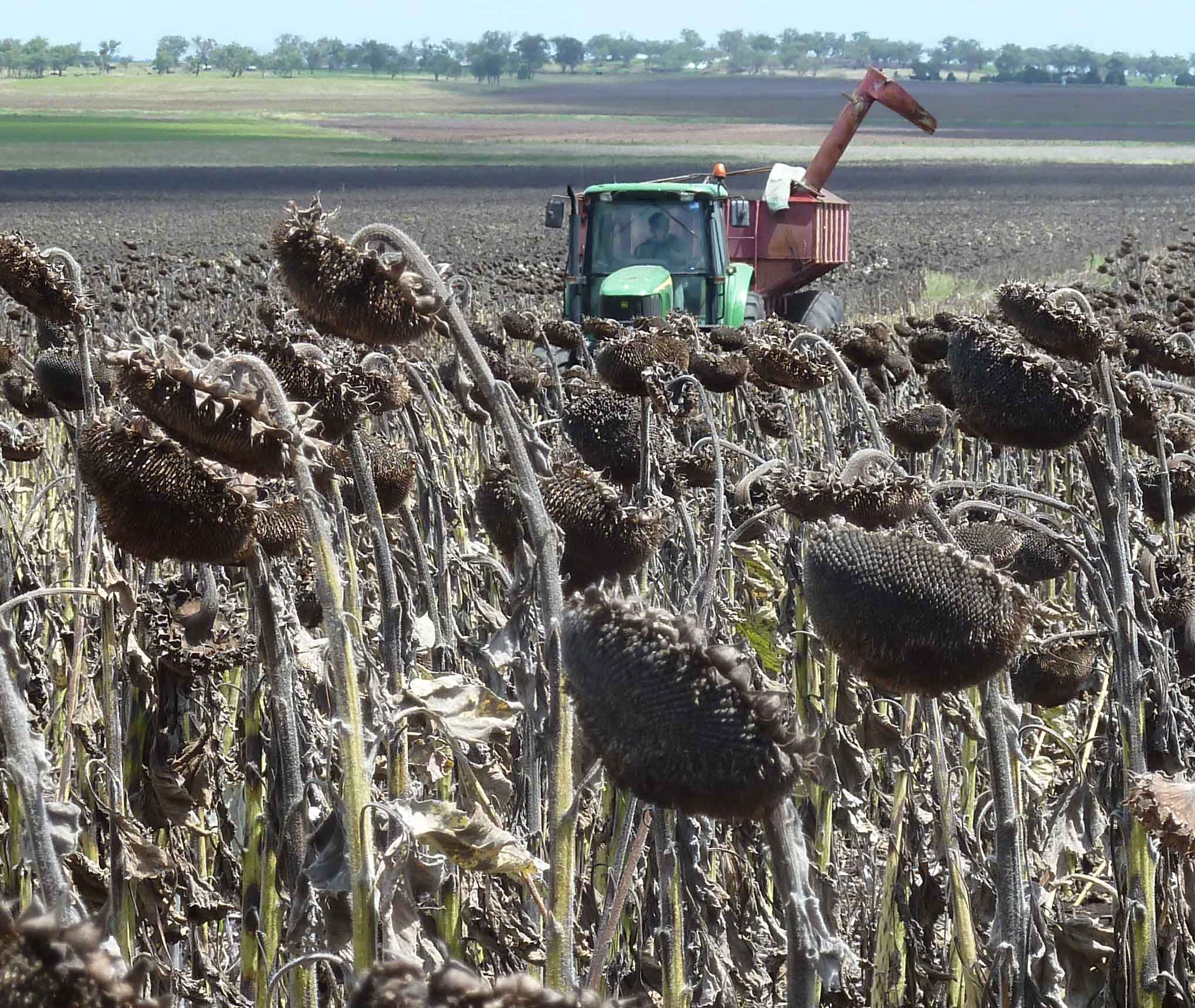Grain bags best practice
Get the best practice tips on storing grain in bags.
Storing planting seed
Philip Burrill explains the best way to store planting seed and why.
Diagnosing pest using digital microscopes
Its not always easy to tell the difference between types of damaging stored grain pests. Mark Stanaway from the Queensland University of Technology can show you how using cheap digital microscopes in these two videos – on Cryptolestes (grain beetles) and Sitophilus (grain weevils)
For assistance identifying storage pests, or confirmation of an identification contact the DAF Queensland postharvest grain protection team on 07 3255 4439 or a member of the Grain Storage Extension Team on 1800 WEEVIL (1800 933 845)
DE Products put to the test (GRDC Ground Cover)
GroundCover™ Supplement Issue: 119 | 02 Nov 2015 | Author: Philip Burrill and Andrew Ridley
Prevention rather than cure is always the best approach when it comes to grain storage hygiene
Diatomaceous earth (DE) is an inert dust made from the fossil remains of diatom skeletons. Diatoms are a type of green or brown algae that grows in freshwater lakes and marine estuaries. There are many species of diatoms and each has a unique size and shape. The various DE products are produced from different mine sites in Australia and overseas and as such have different properties. The way DE is processed also affects its insecticidal properties.
Loading grain into an infested silo guarantees problems down the track. On the other hand, diligently cleaning empty storages and grain-handling equipment significantly reduces the number of pest breeding sites on-farm.
The best hygiene results come from physically cleaning out/washing down residues, followed by a diatomaceous earth (DE) treatment. However, grower queries about the effectiveness of different DE products prompted Queensland Department of Agriculture and Fisheries (DAF) researchers to put them to the test.
Queensland DAF researchers in Brisbane tested the efficacy of four commercial DE products: Dryacide®, Permaguard®, Cut’n’dry® and Absorbacide®.
Three of the most common stored grain pests, the lesser grain borer (Rhyzopertha dominica), the rice weevil (Sitophilus oryzae) and the rust-red flour beetle (Tribolium castaneum) were contained on sections of steel treated with label rates of the DE products.
Dryacide® was the fastest-acting product for all three species tested. The most significant difference between products was their efficacy against the rust-red flour beetle, with only two products showing acceptable results. Product performance from best to worst was – Dryacide®, Permaguard®, Cut’n’dry® and Absorbacide® (Figure 1).

Figure 1 Efficacy of four DE products and a no treatment control over three weeks against red-rust flour beetles.
SOURCE: Queensland DAF
Application
DE can be applied to structures and equipment either as a dry dust or added to water to form a slurry. The rate for dust application (straight out of the bag) is two grams per square metre, which is equivalent to one kilogram of DE over 500m². A Blow-Vac gun is one option for application.
DE dust can also be mixed into water at 120g dust per litre of water and applied at a rate of 5L/100m², giving an application of approximately 6g/m² dry basis to the storage structure.
The label specifies a flat fan nozzle with at least 5L per minute flow rating, so an XR11015VK ceramic nozzle would be a suitable choice. The ceramic will withstand the abrasion much longer than a plastic nozzle. At 3-bar this nozzle will flow at 5.9L per minute.
Grain treatment
The label allows for DE’s use as a grain treatment. The problem for grain treatments at the label rate of 1kg DE/tonne of grain is that it affects grain flow characteristics and therefore handling. It also has an impact on grain ‘angle of repose’.
For this reason most bulk-handling companies and other grain buyers do not accept bulk grain treated with DE.
The presence of DE in grain can also impact on milling quality and there may be other specific market objections to DE dust application to bulk grain.
Always check with buyers before applying it to grain. Current retail cost for DE ranges from $6 to $10/kg, making it an expensive treatment for bulk grain.
Notes on use

The lesser grain borer.
PHOTO: Queensland DAF
DE dust particles kill insects by absorbing some of the waxy layer covering the insect’s body. Damage to this outer ‘water-proofing wax layer’ leads to desiccation and eventual death over several days.
Research in the US indicates DE’s impact on the insect’s body is both abrasion and desiccation. Therefore, DE works best in low-humidity conditions. Stored cereal grains, such as wheat, must be at no greater than 12 per cent moisture content (60 per cent relative humidity) for DE to be effective.
DE is one of the few products available as a structural treatment suitable for all cereal grains, pulses and oilseeds. Chemical insecticides such as fenitrothion can lead to chemical residues on oilseeds and pulses being detected by domestic and export grain buyers if used inappropriately.
The best approach for all storages and equipment is to physically clean and/or water wash all grain residues and dust, then consider using a DE structural treatment to deal with any remaining pests.
Asset Depreciation Change
Philip Burrill provides tips when taking advantage of the governments accelerated depreciation rules.
Equilibrium Moisture Content Charts for Grains Storage Management – PAMI Saskatchewan 2015
Storage Checklist
A grain storage template for growers to record site information, best practice activities and records. Also includes a guide to grain storage best practice.
Identification of the flat grain beetles (Cryptolestes spp.) of Australia – DAF
Three species of flat grain beetles (Cryptolestes spp.) occur in stored grain in Australia. Adults are fast moving, small (2mm), flat, with longer antennae than most stored grain pests. Cryptolestes species occur in all grain growing regions of Australia. One species, the rusty grain beetle, Cryptolestes ferrugineus, has developed a strong resistance to phosphine at a number of sites in eastern Australia. Correct identification of this pest will facilitate appropriate management practices. Following is a guide to the identification of flat grain beetle species in Australia.
Safe Storage of Sunflower Seed – Aeration Drying and Cooling
Grain Storage Fact Sheet February 2015
Results of aeration trials supported by the Australian Oilseed Federation Oilseed
Development Fund and the Australian Sunflower Association as part of the
Broadleaf Cropping Alliance, a Grains Research and Development Corporation funded
initiative.
Key Points:
- Aeration drying and cooling enables safe storage of sunflower seed across a broad range of moisture contents and ambient temperatures.
- Optimal sunflower seed storage occurs below 9 per cent MC at 40 per cent oil content. For higher oil contents (≥50 per cent), store sunflower seed at 7.5 per cent MC.
- Moisture content can be lowered two to three per cent in less than a week with aeration drying.
- Reliable aeration drying requires fan airflow rates in excess of 15 litres per second per tonne (L/s/t), while aeration cooling requires airflow rates of between 2 to 4 L/s/t.
- Aeration cooling fans can reduce seed temperatures in storage by more than 10°C in two to three days.
- Sunflower oil quality can be maintained with well-managed aeration drying and cooling systems.
A moisture content range of 7.5 – 9.0 per cent in storage, is optimal to reduce the risk of moulds and storage pests, while maintaining seed oil quality.
Aeration drying offers the flexibility to start harvest early (at high seed moisture contents) and the ability to harvest for more hours each day. Aeration cooling delivers cool, dry and uniform conditions during storage to maintain optimal seed quality.
Growers who successfully manage sunflower seed moisture and temperature during storage can build a reputation for supplying a consistent quality of sunflower seed that maximises market opportunities in the short and long term.
When designing storage systems, seek independent technical advice on the correct equipment and operating procedures.
On-farm trials support aeration drying
On-farm trials in three silos run by Department of Agriculture Fisheries and Forestry Queensland (DAFF QLD) revealed that using aeration drying at harvest can allow growers the flexibility to harvest sunflowers at high moisture contents (≥13 per cent MC) provided the appropriate size fans are used.
During the trial, the first small load of harvested sunflower seed delivered into the Kotzur silo was measured at 13.7 per cent MC. After subsequent loads, and prior to drying commencing, the bottom third of the silo averaged 12.6 per cent MC, the middle section 10.5 per cent MC and the top portion 9.6 per cent MC (see Figure 1).
After six days of aeration drying, the sunflower seed moisture content was reduced to 5.6 per cent at the bottom, 7.5 per cent in the middle and 9.4 per cent in the top section of the silo.
Note: Averaging silo moisture contents, drying could have ceased on day five to meet delivery standards.
Aeration drying equipment
Aeration drying requires airflow rates in the order of 15 to 25 L/s/t to reliably move drying fronts quickly through the full grain bulk.
For the DAFF QLD trial, a Kotzur drying silo of 75 m3 capacity, holding 27 t of sunflower seed was fitted with a DF 4000 7.5 kW three-phase fan to deliver the airflow rates of 25 to 30 L/s/t.
On a larger 140 m3 cone-based Grainmaster silo, two F650, 1.5 kW singlephase fans were retrofitted. The F650 fans delivered 17 L/s/t to dry 58 tonnes of seed.
High airflow rates can be achieved for drying partly because of the large size and low density (e.g. 41 kg/hL) of sunflower seed, which creates sizeable air gaps between seeds and reduces the back pressure the fans work against. Fan performance is reduced when used on smaller grains such as sorghum and canola, or when the fans work against greater depths of grain in a larger silo.
Drying fan operations
Fan run-times during the trial were managed using a GrainSafe 5000™ aeration controller. The aim was to push drying fronts completely through the full grain depth by maximising fan running hours each day.
During the first two days the controller was set to run fans while the ambient air was less than 75 per cent relative humidity (RH ). For the remaining four days the drying settings were altered to use all ambient air below 65 per cent RH .
Ambient air below 75 per cent RH is less than the equilibrium of 9 per cent MC of sunflowers. The second stage of drying using ambient air below 65 per cent RH drives towards moisture contents of less than 8 per cent (see Table 1).
Regular sampling is required to ensure seed is not over dried.
Cost of drying
As ambient conditions for aeration drying vary, a conservative estimate of six days has been used to calculate the cost of drying during the trial.
Over the six days the fan run-time totalled 67 hours. Using a charge rate of $2.10 per hour to run the 7.5 kW fan, this indicates total electricity costs of $140 to dry the 27 t of seed — approximately $5/t.
Benefits of aeration drying
The flexibility to harvest sunflowers early and deal with high seed moisture content has numerous advantages including:
- reduced risk of weather damage to the standing crop;
- less fire risk in harvesters or grain dryers;
- extended harvest days and the ability to resume more quickly after rain events, and
- maximised saleable tonnage and income by limiting over-dry sunflower seed towards the end of harvest.
Managing admixture
Aim to start harvesting sunflower seed when moisture content is in the range of 10 – 12 per cent and check for acceptable admixture levels in the seed sample. Aim for no more than 2 per cent admixture and keep below the 4 per cent maximum receival limit. Watch for fine admixture in the sample. Incorporating a perforated section in the harvester outload auger and other augers can reduce admixture fines.
Cooling during storage
In addition to the use of drying fans at harvest to manage high-moisture seed, aeration cooling during storage, using low airflow rates of 2 to 4 L/s/t, can be used to reduce seed temperature and create uniform moisture conditions throughout the storage bulk. This reduces the risk of moulds, storage pests and seed oil quality deterioration.
Aeration cooling trial
During March on the Darling Downs, 65 t of monounsaturated sunflower seed was harvested at between 8 to 9% MC and stored in an aerated 158 m³ capacity cone-based silo.
The silo was fitted with two standard, single-phase 0.37 kW aeration cooling fans (F370) providing 7 L/s/t airflow. Sunflower seed has a lower back pressure than other grains, so the cooling airflow rate for this trial was above the typical 2 to 4 L/s/t.
Cooling fan operations
A Grainsafe 5000™ controller set aeration fans to run through its automatic cooling management program. Typically, this is an initial five days of continuous fan run time, followed by a purge fan run of seven days taking 9 to 12 hours per day of cool air, concluded by the longer term protect fan setting. In most cases, the protect setting runs fans for about 100 hours per month, selecting the best available ambient air. To protect grain, all cooling settings automatically stop fans during times of air humidity above 85 per cent (RH ).
Cooling results
Sunflower seed temperature in the silo was monitored continuously for six weeks from mid-March into April.
Prior to aeration, harvested seed temperatures in storage were above 35°C (see Figure 2). Two days of aeration reduced seed temperature by 10°C to less than 25°C.
With warm ambient temperatures during the second week of aeration, seed temperatures rose briefly. By week four seed temperatures fell to 20°C, then finally to less than 15°C by week six.
Sunflower oil quality
High-quality monounsaturated oil is the major end product for sunflower seed in Australia, so it is important to maintain oil quality during storage and handling.
Poor seed storage conditions, which expose sunflower seed to excess moisture and heat, can degrade oil quality by raising levels of free fatty acids (FF A).
During the aeration drying and cooling trials outlined here, sunflower seed was sampled before and after storage from all silos.
Samples were submitted for analysis and the results demonstrated no increase of FF A levels as a result of aeration drying or cooling (see Table 2.)
Further reading
Safe Storage of Sunflowers, www.bettersunflowers.com.au/bysp/storage
The Big Yellow Sunflower Pack Module 7 Safe storage, https://bettersunflowers.com.au/public/safestorage/#/0
Dealing with high-moisture grain (GRD C Fact Sheet), www.storedgrain.com.au/dealing-withhigh- moisture-grain/
Aerating Stored Grain – Cooling or Drying for Quality Control (GRD C Booklet), www.storedgrain.com.au/aeratingstored- grain/
Storing oilseeds (GRD C Fact Sheet), www.storedgrain.com.au/storingoilseeds/
Grain storage specialists
Philip Burrill
1800 933 845
Email: philip.burrill@daff.qld.gov.au
Authors:
Philip Burrill DAFF Qld,
Andrew Ridley DAFF Qld.
Acknowledgements:
Rob and John Piper and families, “Itchelby” Felton.
Mark Conway, Control Unlimited P/L.
Alan Andrews, Customvac P/L.
Kevin Charlesworth, “Mirradong” Clifton.
Liz Alexander, Blue Dog Agribusiness, Emerald.
The aeration trials were supported by the Australian Oilseeds Federation (AOF) Oilseed Development Fund and the Australian Sunflower Association as part of the Broadleaf Cropping Alliance, a Grains Research Development Corporation funded initiative.









